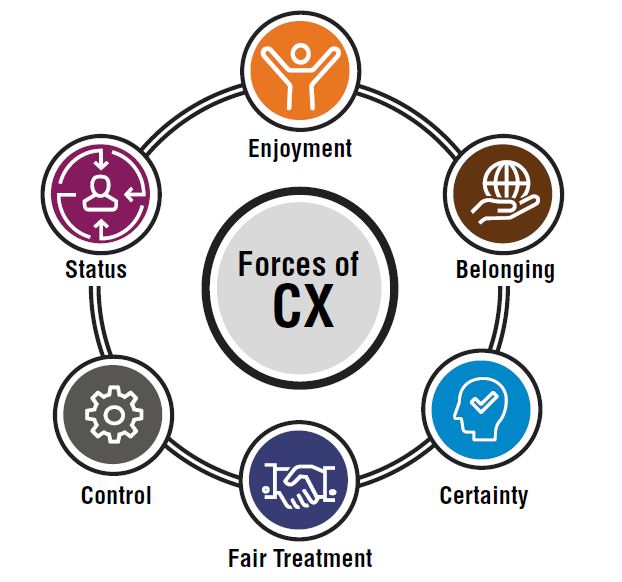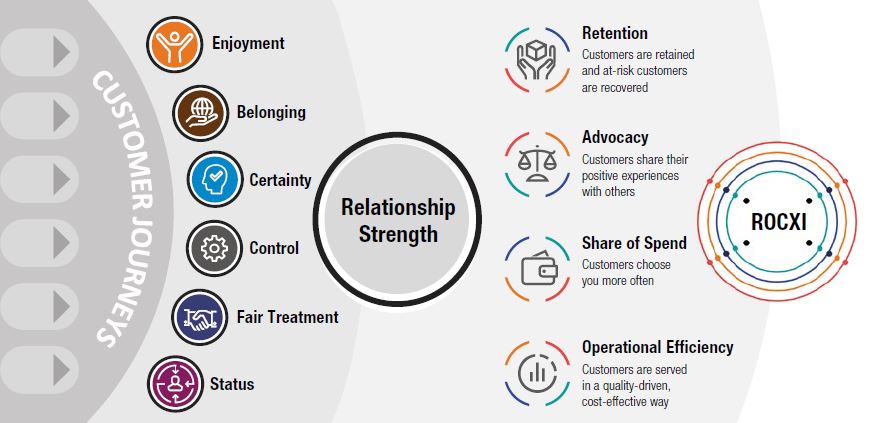Organisational responses to COVID-19 based on the Forces of CX
The Forces of Customer Experience
Ipsos R&D over the last 12 months proves the link between establishing an emotional connection with customers, relationship strength and ultimately business performance. The gains are significant: an emotionally attached customer is far more likely to prefer your brand, recommend your product or service, remain a customer – and forgive you if you’ve made a mistake. Sadly, organisations often struggle to understand how to design and deliver experiences that go beyond the transactional to create long-term positive memories and true competitive advantage.
To remedy this, Ipsos has distilled the essence of emotional attachment on relationship strength into six key ingredients – or Forces – of customer experience.
By focusing on these six drivers of emotional attachment and relationship strength, you in turn can realise the benefits of improved retention, advocacy, share of spend and operational efficiency, which are all key indicators of return on CX investment (ROCXI).

COVID-19 with a CX Forces Lens
Customer behaviour is influenced by the touchpoints or ‘moments’ we have with a brand. These become aggregated into memories, which affect how we behave with brands in the future.
Right now, there’s a unique opportunity for brands to create positive memories, earn trust and develop deeper customer relationships by maintaining presence, delivering relevant value in a fluid period of heightened anxiety and being a trusted source of accurate information.
Organisations are activating these opportunities through small gestures and wholesale business process change alike, positively impacting the customer sufficiently to be remembered and influence behaviour in the future.
In the following articles, we shine a light on some of the best examples of delivering on the values of our CX Forces during the COVID-19 outbreak, providing practical examples showing how it is possible to build emotional connection with your customers.
Follow these links to discover which brands have used the following Forces to deliver exceptional customer experience, in Fairness, Certainty, Control, Status, Belonging and Enjoyment.
Key takeaways
Consistency is king
This paper showcases some of the best customer experience responses to individual moments we’ve seen since the start of lockdown. But consistency is king - organisations require a systematic approach to customer experience delivery because it is the aggregation of each moment that becomes the memory. Excellent customer experience delivered in silos isn’t enough.
Putting the CX Forces into action
Use the CX Forces framework to determine the optimal customer experience design. There are three key steps: Diagnose, Prioritise and Design.
- See where you stack up – what are the barriers and what are the drivers of performance for each Force?
- Map the performance and importance of customer touchpoints and align them with the Forces framework. Are there are gaps in your customer journey that you could optimise for a better customer experience?
- Use the Forces as a core part of customer experience design to better map journeys using this human-centric framework.
Delivering a return on CX Investment (ROCXI)
By focusing on the CX Forces, the six drivers of emotional attachment and relationship strength, you in turn can realise the benefits of improved retention, advocacy, share of spend and operational efficiency, which are all key indicators of return on CX investment (ROCXI).



